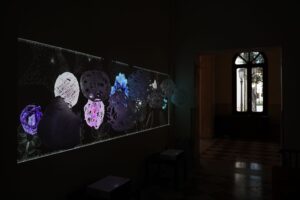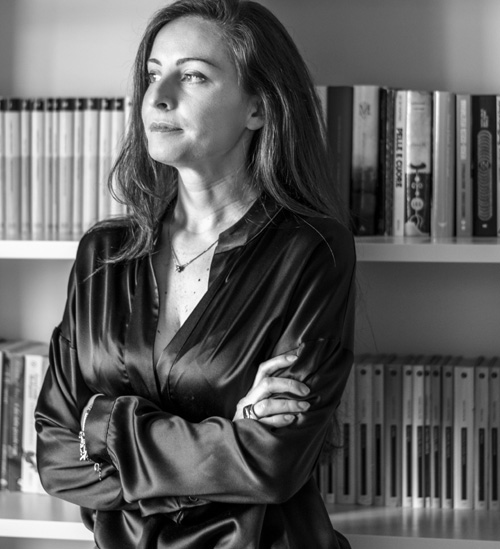There exist totalizing forms of art capable of uniting geophysical research and social realities with intuition and acute investigative power, thus delineating suggestive new visions of the world. Regarding this, in line with the reflections surrounding the topics developed during the 60th Venice Biennale, “TRAVELLERS MIRROR CITIES” originated, curated by Miriam Sun and Giuliana Benassi organized by the MoCA museum of Shanghai, in collaboration with Venice International University. Numerous artists have been invited to participate in the project, all engaged in tracing visions inspired by the complex relationship of forces woven between the natural rhythm of the urban life and the virtual elements. The group show postulates the necessity of knowing, first and foremost, human nature, thus offering anthropocentric visions strongly focused on the individual as a stranger willing to investigate their own biological nature and everything that surrounds them. Therefore, it is legitimate, in the face of this exhibition, to question the extent to which the artist’s gaze perceive the fractures of the urban fabric and the repercussions on the humans who inhabit it, also reconsidering the relationship with one’s own nature, to develop a new ethical, aesthetic, and biological consciousness.

Rä di Martino, “L’Eccezione”, 2019. Video HD, 4’’. Courtesy the artist
In this way, the light installations, videos, and sculptures create an environment like a welcoming womb, protecting an immersive art, played on the relationship between the natural and the artificial, to the extent of suggesting fascinating and attractive meditations to the viewer. Following this, the questions asked to some protagonists demonstrates how the theme of the project is not devoid of limits and novelties, whereby all artistic expressions are primarily related to new sensations of fruition, allowing the visual and narrative contributions to be grasped with truly innovative methods. In this manner, both Rä di Martino and Yang Yongliang convey the invaluable values of freedom and aspiration towards the creation of new territories. While from the words of curator Miriam Sun, the spirit of an exhibition animated by multiplicity and new connections emerges, where anyone is free to immerse themselves and experience their fluid journey. Consequently, the viewer is invited to reflect not so much in a specific geographical place, but in a virtual reality, in which they are naturally a stranger, and whose strength lies not in the specification of an area, but in its shimmering and visionary forms of interpretation that the artists provide, making us feel their revolutionary pressure.

Fu Tong, “Flowing Bodies”, 2023. Audio video installation. Ph. Credit MoCA Shangai
Maria Vittoria Pinotti: As the executive director of the MoCA in Shanghai, could you explain the reasons behind this project?
Miriam Sun: In the twenty years since the opening of the MoCA – happened in 2005 – we have established a deep collaboration with ambassador Umberto Vattani, the Italian government, and the International University of Venice. This exhibition is the twelfth we have organized in Italy and the sixth project we have planned together with the ambassador. In 2009, for example, we invited to expose at the International University of Venice twelve renowned Chinese artists part of the movement “85 Trendy” – the first nationwide avant-garde current in the history of 20th-century Chinese art – to create the exhibition “Gift for Marco Polo”. Fifteen years later, such as now, we have invited the new generation of Chinese and Italian artists and, through their works, exhibited in the group show “TRAVELLERS MIRROR CITIES”, we aim to account for the seven hundred years since Marco Polo, echoing the spirit of the theme of the 60th Venice Biennale “Foreigners Everywhere”. The exhibition hence unfolds through a multi-voice dialogue, returning images that are often contrasting or, conversely, specular. The same artists, Chinese and Italian, reflect each other: individually through their own imagery carries with them the result of crossing places and visions, of spatial and temporal dimensions. This exhibition is an unprecedented journey, traversing our way of understanding art shows, from painting, to video, sculptures and installations, as well as scientific research and sound, until the joint efforts of Chinese and Italian artists. It is a nomadic form and a brand-new way of presenting culture to come together in the theater of art.

Fu Tong, “When I think of you”. Ph. Credit MoCA Shangai
The title of the exhibition refers to the travelers’ ability to reflect the city. The Italian writer Giorgio Manganelli stated that «the mirror is a sacred and mythical object, as it is synonymous with an endless depth: what it reflects is the result of an eternal complicity between reality and the testimony it reflects».[1] Could the research of the artists on view be considered as a natural reflection of the relationship between the artist and the city? If so, are the artists physical, mental, or virtual travelers?
Miriam Sun: Giorgio Manganelli perfectly interprets the philosophy of the exhibition. Cities, as geographical, social, and cultural spaces, contain numerous layers of value that are not immediately visible. This exhibition sets within the context of the Venice International University, a space dedicated to international knowledge exchange. “TRAVELLERS MIRROR CITIES” aims to ingeniously construct a conceptual artistic journey on the city of the traveler, understood as a spiritual mirror image of oneself and the stranger, weaving a dynamic narrative with two threads, one apparent and the other hidden. By using the non-linear presentation of artworks by Chinese and Italian artists and throughout the different artistic languages (i.e., the apparent thread), the exhibition intends to urge travelers to continue asking questions to the city, prompting them with new inquiries when they are interacting with art, guiding them to seek the reflection of themselves in the mirror within the city’s responses (i.e., the hidden thread). In this way, the purpose of the exhibition is not only to help travelers in finding the answers to the city’s visual enigmas, but also to outline their self-reflection and encourage their further contemplation of interpersonal relationships. As Italo Calvino writes in a dialogue between Kublai Khan and Marco Polo in his novel “Invisible Cities”, regarding the City of Utopia, even if we have not discovered it, we cannot abandon our efforts to search for it. It is therefore necessary to start from history and look to the new era to create a “symbiotic network” of stage in which coal-based life and silicon-based life dialogue with each other, and finally invite the public to share the beauty in their own way, with their own path and interaction. This text was fundamental to the realisation of the curatorial concept behind the exhibition, Calvino gave us nomadic images across different worlds: commercial, ideological and aesthetic nomadism. The entire Earth (including outer space, as well as virtual worlds parallel to the real world) thus becomes one theatre. “TRAVELLERS MIRROR CITIES” thus manifests itself as a holistic artwork combining the latest frontiers of contemporary art, science and technology, literature and thought. All the spatial sections of the exhibition, both inside and outside, are one of the logical links in this theatrical work as a whole. Each exhibition is a “mail station” for the nomadic audience, who can stop to rest for a spiritual moment and engage in an emotional, aesthetic and conceptual dialogue.

Yang Yongliang, “The Moonlight”, series. Digital photography. Ph. Credit MoCA Shangai
Your work appeals on the audience to imagine the story of a sculptural fragment, proposing a unique experience: for what purpose do you build new life forms?
Rä di Martino: In my work “L’eccezione”, I aimed to portray the concept of potentiality. A broken statue abandoned in a park (an image I derived from a photo of the same subject) wakes up and tries to dance as best it can to the notes of Giorgio Moroder’s “Flashdance (What A Feeling)” leitmotif. At first, the movement is very slow and minimal, but at a certain point, it almost manages to follow the rhythm of the song. In the end, there is a burst of colors, a flash of digital pink, almost reminding that everything is artificial and fake.

Qiu Anxiong, “Tian Zhi Xiu Yue-é”. Ph. Credit MoCA Shangai
Analysing your works naturally recalls the Italian writer Italo Calvino, who combined deeply scientific interests with fantastic narratives, embedding intelligent and profound inner solicitations. One of his short stories entitled “The Distance of the Moon” narrates the impossible story of a group of people who went to the satellite planet in search of a nutritious milk they fed on. In this place «regions stretched out that we had never had reason or curiosity to explore. It was a preparation, a prelude, to something secret that had to take place in hidden areas».[2] You are also particularly drawn to the subject of the moon: how much do you reflect yourself in this description?
Yang Yongliang: I am an admirer of Calvino’s works, and I find the themes he explored in his writings fascinating and easily relatable. I have not read “The Distance of the Mon”, but I would like to share another interesting idea that comes from ancient Chinese folk tales and that intrigued me and that I have incorporated into my works “Moonlight”. I depicted the moon as a flat disk to pay homage to the ancient romantic belief that the moon is an illuminating disk. In historical Chinese literature, the charm of the moon is associated with nostalgia. The luminous disk is thus symbol of the nostalgia for home shared with distant travelers, nostalgia for family and separated friends who can observe the same image at the same moment, even from afar. It is interesting to discover that Calvino describes the moon as a travel destination, while the traditional perspective of admiring the moon with which I grew up has taught me to see it as an unreachable place.
Maria Vittoria Pinotti
[1] Giorgio Manganelli, Emigrazioni oniriche: Scritti sull’arte, Adelphi, Milano, 2023, p.241.
[2] Italo Calvino, La distanza della Luna, in Le cosmicomiche, Mondadori, Milano, 2019, pp.7-8.
Info:
various artists, TRAVELLERS MIRROR CITIES
curated by Giuliana Benassi and Miriam Sun
17/04/2024 – 18/05/2024
VIU – Venice International University
Isola di San Servolo 30133, Venezia
univiu.org

Maria Vittoria Pinotti (1986, San Benedetto del Tronto) is an art historian, author, and independent critic. She currently is the coordinator of Claudio Abate’s photographic archive and Manager at Elena Bellantoni’s Studio. From 2016 to 2023 she was the Gallery Manager in a gallery in the historic center of Rome. She has worked with ministerial offices such as the General Secretariat of the Ministry of Culture and the Central State Archive. Currently, she collaborates with cultural sector magazines, focusing on in-depth thematic studies dedicated to modern and contemporary art.






NO COMMENT